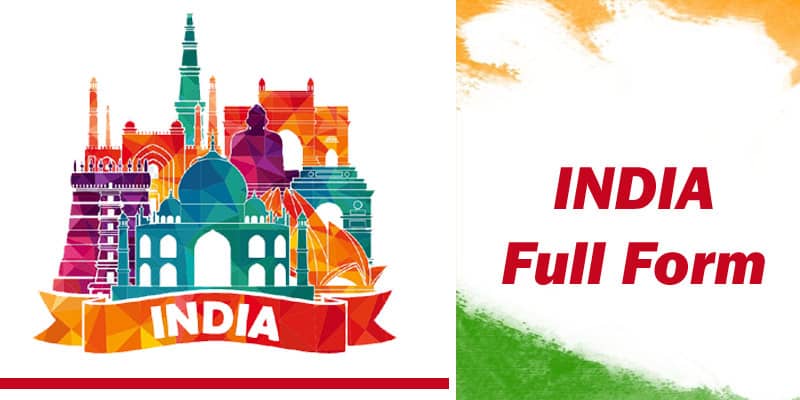My India, My Pride, My Nation, Unity in Diversity are some of the words automatically generated in the back of our heads when we hear the word INDIA.
INDIA Full Form
You must be thinking, is there any full form of India as the article is named full form of India. Well, let me guide you through this. There is no particular full form of India, but there is a long history behind how India was named as ‘India.’ Read below to know more.

- The name “India” has been derived from the River Indus. The Aryan worshippers referred to the river Indus as the Sindhu.
- The Muslim invaders converted Sindhu into Hinduism. The name ‘Hindustan’ combines Sindhu and thus refers to the land of the people living beyond the Sindhu river.
- India is one of the oldest civilizations in the world, with a kaleidoscopic variety of religions and a rich cultural heritage.
- India is a South Asian country. It is the 7th largest country by area but the second largest country by population. The capital city of India is currently Delhi, previously changed from Kolkata in 1911. There are 29 states and seven union territories. Significant parts of the country experience a tropical monsoon climate.
- The Indian Ocean bounds India on the south, the Arabian Sea on the south-west, and the Bay of Bengal on the south-east.
- The Indians established Harappan culture in the Sindhu Valley (Indus Valley Civilization).
- There are many inventions, developments, and research initiated by Indians. Chess was invented in India. Algebra, trigonometry, and calculus are topics that originated in India. The “Place Value System” and the “decimal system” were developed in India in 100 B.C. Aryabhatta founded the letter “0” (zero). Algebra, trigonometry, and calculus also originated in India.
- Every state has its own unique identification; Kolkata being the ‘City of Joy’; Jaipur, in Rajasthan, is called the ‘Pink City. Bangalore, the capital city of Karnataka, is known as the City of Gardens; Varanasi, in Uttar Pradesh, is the oldest and holiest city in the country. Amritsar in Punjab is known as the “Golden City” for having the famous Golden Temple situated on its land. Kashmir lies in the lap of the Great Himalayas. The Seven Sisters states are the destinations for scenic beauty.
- India is the world’s second-largest producer of agricultural products such as wheat (in Uttar Pradesh), rice (in West Bengal), sugarcane (in Uttar Pradesh), cotton (in Gujarat), tea (in Assam), coffee (in Karnataka), several dry fruits, and the largest producer of millets, ginger, okra, buffalo milk, and cow milk in the world and the second-largest producer of wheat, rice, onion, and cabbage.
- The Indian economy is the fastest-growing economy in the world. Natural resources like coal, petroleum, natural gas, bauxite, iron ore, mica, diamonds, etc., are found in India. Hindi, English, and other 21 languages are spoken in the official country of India.
- India is witnessing growth in every sector, be it automobiles or e-Commerce, renewable energy, tourism, textiles, manufacturing, or IT.
- India is already a global leader in the information technology sector and is becoming a challengeable hardware exporter by reckoning its weaknesses.
- Many schemes are being launched by the government to boost the small and medium industries in India.
- The pace of development India is experiencing is very high, and experts believe it may soon regain its position as a global leader.
Conclusion
India is our pride and nation. It has a pot where diverse religions, faiths, and beliefs come together. It has a rich history of culture and traditions. We should be proud of our nation and always work towards its betterment.

